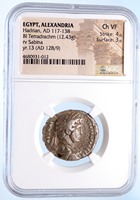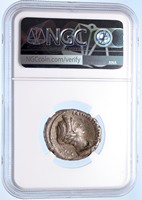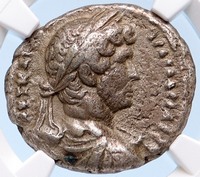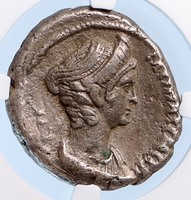Hadrian - Roman Emperor: 117-138 A.D.
Billon Tetradrachm 24mm (12.43 grams) of Alexandria in Egypt, Dated RY 13, struck 128/129 A.D.
Reference: Köln 997; Dattari (Savio) 1249; K&G 32.469; RPC III 5729/25; Emmett 886.13; Staffieri, Alexandria In Nummis 91
Certification: NGC Ancients Ch VF Strike: 4/5 Surface: 3/5 4680931-012
AVT KAI TPAI A∆PIA CЄB, laureate, draped, and cuirassed bust right of Hadrian.
CABINA CЄBACTH, draped bust right of Sabina, wearing stephane; L IΓ (date) upward behind.
This type was minted beginning in Hadrian's regnal year 13, one year before his arrival in Egypt, and continued through his 20th regnal year. You are bidding on the exact item pictured, provided with a Certificate of Authenticity and Lifetime Guarantee of Authenticity.
_01.jpg/180px-Busto_de_Vibia_Sabina_(M._Prado)_01.jpg) Vibia Sabina (83-136/137) was a Roman Empress, wife and second cousin, once removed, to Roman Emperor Hadrian. She was the daughter to Salonina Matidia (niece of Roman Emperor Trajan), and suffect consul Lucius Vibius Sabinus. After her father's death in 84, Sabina along with her half-sisters lived with their grandmother, mother and were raised in the household of Trajan, his wife Pompeia Plotina and her stepfather. Vibia Sabina (83-136/137) was a Roman Empress, wife and second cousin, once removed, to Roman Emperor Hadrian. She was the daughter to Salonina Matidia (niece of Roman Emperor Trajan), and suffect consul Lucius Vibius Sabinus. After her father's death in 84, Sabina along with her half-sisters lived with their grandmother, mother and were raised in the household of Trajan, his wife Pompeia Plotina and her stepfather.
She married Hadrian in 100, at the Roman Empress Pompeia Plotina's request, for Hadrian to succeed her great uncle, in 117. Sabina's mother Matidia (Hadrian's second cousin) was also fond of Hadrian and allowed him to marry her daughter. They had no children and had an unhappy marriage. Sabina was said to have remarked that she had taken steps to see she never had children by Hadrian because they would "harm the human race". It seems that she once aborted a child of theirs. Sabina was strong and independent and her beliefs in marriage didn't sit well with the Emperor. Sabina had an affair with Suetonius a historian (and Hadrian's secretary) in the year 119. In 128, she was awarded the title of Augusta. Vibia Sabina died before her husband, some time in 136 or early 137. Vibia Aurelia Sabina (170-died before 217), daughter and youngest child of Roman Emperor Marcus Aurelius and Roman Empress Faustina the Younger was a great, great niece to Vibia Sabina. Her name was bestowed in honor of Sabina and her father.
| First-cousin-once-removed and adopted son of Trajan | Husband of Sabina | Adoptive father of Aelius and Antoninus Pius | Grand-nephew of Trajan Pater | Publius Aelius Hadrianus (as emperor Imperator Caesar Divi Traiani filius Traianus Hadrianus Augustus, and Divus Hadrianus after his apotheosis, known as Hadrian in English; 24 January 76 - 10 July 138) was emperor of Rome from AD 117 to 138, as well as a Stoic and Epicurean philosopher. A member of the gens Aelia, Hadrian was the third of the so-called Five Good Emperors. Hadrian was born Publius Aelius Hadrianus in Italica or, less probably, in Rome, from a well-established family which had originated in Picenum in Italy and had subsequently settled in Italica, Hispania Baetica (the republican Hispania Ulterior), near the present day location of Seville, Spain. His predecessor Trajan was a maternal cousin of Hadrian's father. Trajan never officially designated a successor, but, according to his wife, Pompeia Plotina, Trajan named Hadrian emperor immediately before his death. Trajan's wife was well-disposed toward Hadrian: Hadrian may well have owed his succession to her. Hadrian's presumed indebtedness to Plotina was widely regarded as the reason for Hadrian's succession. However, there is evidence that he accomplished his succession on his own governing and leadership merits while Trajan was still alive. For example, between the years AD 100-108 Trajan gave several public examples of his personal favour towards Hadrian, such as betrothing him to his grandniece, Vibia Sabina, designating him quaestor Imperatoris, comes Augusti, giving him Nerva's diamond "as hope of succession", proposing him for consul suffectus, and other gifts and distinctions. The young Hadrian was Trajan's only direct male family/marriage/bloodline. The support of Plotina and of L. Licinius Sura (died in AD 108) were nonetheless extremely important for Hadrian, already in this early epoch. The Stoic-Epicurean Emperor traveled broadly, inspecting and correcting the legions in the field. Even prior to becoming emperor, he had traveled abroad with the Roman military, giving him much experience in the matter. More than half his reign was spent outside of Italy. Other emperors often left Rome to simply go to war, returning soon after conflicts concluded. A previous emperor, Nero, once traveled through Greece and was condemned for his self indulgence. Hadrian, by contrast, traveled as a fundamental part of his governing, and made this clear to the Roman senate and the people. He was able to do this because at Rome he possessed a loyal supporter within the upper echelons of Roman society, a military veteran by the name of Marcius Turbo. Also, there are hints within certain sources that he also employed a secret police force, the frumentarii, to exert control and influence in case anything should go wrong while he journeyed abroad. Hadrian's visits were marked by handouts which often contained instructions for the construction of new public buildings. Hadrian was willful of strengthening the Empire from within through improved infrastructure, as opposed to conquering or annexing perceived enemies. This was often the purpose of his journeys; commissioning new structures, projects and settlements. His almost evangelical belief in Greek culture strengthened his views: like many emperors before him, Hadrian's will was almost always obeyed. His traveling court was large, including administrators and likely architects and builders. The burden on the areas he passed through were sometimes great. While his arrival usually brought some benefits it is possible that those who had to carry the burden were of different class to those who reaped the benefits. For example, huge amounts of provisions were requisitioned during his visit to Egypt, this suggests that the burden on the mainly subsistence farmers must have been intolerable, causing some measure of starvation and hardship. At the same time, as in later times all the way through the European Renaissance, kings were welcomed into their cities or lands, and the financial burden was completely on them, and only indirectly on the poorer class. Hadrian's first tour came in 121 and was initially aimed at covering his back to allow himself the freedom to concern himself with his general cultural aims. He traveled north, towards Germania and inspected the Rhine-Danube frontier, allocating funds to improve the defenses. However it was a voyage to the Empire's very frontiers that represented his perhaps most significant visit; upon hearing of a recent revolt, he journeyed to Britannia. Prior to Hadrian's arrival on Great Britain there had been a major rebellion in Britannia, spanning roughly two years (119-121). It was here where in 122 he initiated the building of Hadrian's Wall (the exact Latin name of which is unknown). The purpose of the wall is academically debated. In 1893, Haverfield stated categorically that the Wall was a means of military defence. This prevailing, early 20th century view was challenged by Collingwood[disambiguation needed] in 1922. Since then, other points of view have been put forwards; the wall has been seen as a marker to the limits of Romanitas, as a monument to Hadrian to gain glory in lieu of military campaigns, as work to keep the Army busy and prevent mutiny and waste through boredom, or to safeguard the frontier province of Britannia, by preventing future small scale invasions and unwanted immigration from the northern country of Caledonia (now modern day Scotland). Caledonia was inhabited by tribes known to the Romans as Caledonians. Hadrian realized that the Caledonians would refuse to cohabitate with the Romans. He also was aware that although Caledonia was valuable, the harsh terrain and highlands made its conquest costly and unprofitable for the Empire at large. Thus, he decided instead on building a wall. Unlike the Germanic limes, built of wood palisades, the lack of suitable wood in the area required a stone construction; nevertheless, the Western third of the wall, from modern-day Carlisle to the River Irthing, was built of turf because of the lack of suitable building stone. This problem also led to the narrowing of the width of the wall, from the original 12 feet to 7, saving masonry. Hadrian is perhaps most famous for the construction of this wall whose ruins still span many miles and to date bear his name. In many ways it represents Hadrian's will to improve and develop within the Empire, rather than waging wars and conquering. Under him, a shrine was erected in York to Britain as a Goddess, and coins were struck which introduced a female figure as the personification of Britain, labeled BRITANNIA. By the end of 122 he had concluded his visit to Britannia, and from there headed south by sea to Mauretania. Parthia and AnatoliaIn 123, he arrived in Mauretania where he personally led a campaign against local rebels. However this visit was to be short, as reports came through that the Eastern nation of Parthia was again preparing for war, as a result Hadrian quickly headed eastwards. On his journey east it is known that at some point he visited Cyrene during which he personally made available funds for the training of the young men of well bred families for the Roman military. This might well have been a stop off during his journey East. Cyrene had already benefited from his generosity when he in 119 had provided funds for the rebuilding of public buildings destroyed in the recent Jewish revolt. When Hadrian arrived on the Euphrates, he characteristically solved the problem through a negotiated settlement with the Parthian king Osroes I. He then proceeded to check the Roman defenses before setting off West along the coast of the Black Sea. He probably spent the winter in Nicomedia, the main city of Bithynia. As Nicomedia had been hit by an earthquake only shortly prior to his stay, Hadrian was generous in providing funds for rebuilding. Thanks to his generosity he was acclaimed as the chief restorer of the province as a whole. It is more than possible that Hadrian visited Claudiopolis and there espied the beautiful Antinous, a young boy who was destined to become the emperor's beloved. Sources say nothing about when Hadrian met Antinous, however, there are depictions of Antinous that shows him as a young man of 20 or so. As this was shortly before Antinous's drowning in 130 Antinous would more likely have been a youth of 13 or 14. It is possible that Antinous may have been sent to Rome to be trained as page to serve the emperor and only gradually did he rise to the status of imperial favorite. After meeting Antinous, Hadrian traveled through Anatolia. The route he took is uncertain. Various incidents are described such as his founding of a city within Mysia, Hadrianutherae, after a successful boar hunt. (The building of the city was probably more than a mere whim - lowly populated wooded areas such as the location of the new city were already ripe for development). Some historians dispute whether Hadrian did in fact commission the city's construction at all. At about this time, plans to build a temple in Asia minor were written up. The new temple would be dedicated to Trajan and Hadrian and built with dazzling white marble. Greece, Judaea, IllyricumHadrian's movements subsequent to the founding of Antinopolis on October 30, 130 are obscure. Whether or not he returned to Rome, he spent the winter of 131-32 in Athens and probably remained in Greece or further East because of the Jewish rebellion which broke out in Judaea in 132 (see below). Inscriptions make it clear that he took the field in person against the rebels with his army in 133; he then returned to Rome, probably in that year and almost certainly (judging again from inscriptions) via Illyricum. Second Roman-Jewish WarSee also: Bar Kokhba revolt In 130, Hadrian visited the ruins of Jerusalem, in Judaea, left after the First Roman-Jewish War of 66-73. He rebuilt the city, renaming it Aelia Capitolina after himself and Jupiter Capitolinus, the chief Roman deity. A new temple dedicated to the worship of Jupiter was built on the ruins of the old Jewish Second Temple, which had been destroyed in 70. In addition, Hadrian abolished circumcision, which was considered by Romans and Greeks as a form of bodily mutilation and hence "barbaric". These anti-Jewish policies of Hadrian triggered in Judaea a massive Jewish uprising, led by Simon bar Kokhba and Akiba ben Joseph. Following the outbreak of the revolt, Hadrian called his general Sextus Julius Severus from Britain, and troops were brought from as far as the Danube. Roman losses were very heavy, and it is believed that an entire legion, the XXII Deiotariana was destroyed.[45] Indeed, Roman losses were so heavy that Hadrian's report to the Roman Senate omitted the customary salutation "I and the legions are well". However, Hadrian's army eventually put down the rebellion in 135, after three years of fighting. According to Cassius Dio, during the war 580,000 Jews were killed, 50 fortified towns and 985 villages razed. The final battle took place in Beitar, a fortified city 10 km. southwest of Jerusalem. The city only fell after a lengthy siege, and Hadrian only allowed the Jews to bury their dead after a period of six days. According to the Babylonian Talmud, after the war Hadrian continued the persecution of Jews. He attempted to root out Judaism, which he saw as the cause of continuous rebellions, prohibited the Torah law, the Hebrew calendar and executed Judaic scholars (see Ten Martyrs). The sacred scroll was ceremonially burned on the Temple Mount. In an attempt to erase the memory of Judaea, he renamed the province Syria Palaestina (after the Philistines), and Jews were forbidden from entering its rededicated capital. When Jewish sources mention Hadrian it is always with the epitaph "may his bones be crushed" (שחיק עצמות or שחיק טמיא, the Aramaic equivalent), an expression never used even with respect to Vespasian or Titus who destroyed the Second Temple. Hadrian spent the final years of his life at Rome. In 134, he took an Imperial salutation or the end of the Second Jewish War (which was not actually concluded until the following year). In 136, he dedicated a new Temple of Venus and Roma on the former site of Nero's Golden House. About this time, suffering from poor health, he turned to the problem of the succession. In 136 he adopted one of the ordinary consuls of that year, Lucius Ceionius Commodus, who took the name Lucius Aelius Caesar. He was both the stepson and son-in-law of Gaius Avidius Nigrinus, one of the "four consulars" executed in 118, but was himself in delicate health. Granted tribunician power and the governorship of Pannonia, Aelius Caesar held a further consulship in 137, but died on January 1, 138. Following the death of Aelius Caesar, Hadrian next adopted Titus Aurelius Fulvus Boionius Arrius Antoninus (the future emperor Antoninus Pius), who had served as one of the four imperial legates of Italy (a post created by Hadrian) and as proconsul of Asia. On 25 February 138 Antoninus received tribunician power and imperium. Moreover, to ensure the future of the dynasty, Hadrian required Antoninus to adopt both Lucius Ceionius Commodus (son of the deceased Aelius Caesar) and Marcus Annius Verus (who was the grandson of an influential senator of the same name who had been Hadrian's close friend; Annius was already betrothed to Aelius Caesar's daughter Ceionia Fabia). Hadrian's precise intentions in this arrangement are debatable. Though the consensus is that he wanted Annius Verus (who would later become the Emperor Marcus Aurelius) to succeed Antoninus, it has also been argued that he actually intended Ceionius Commodus, the son of his own adopted son, to succeed, but was constrained to show favour simultaneously to Annius Verus because of his strong connections to the Hispano-Narbonensian nexus of senatorial families of which Hadrian himself was a part. It may well not have been Hadrian, but rather Antoninus Pius - who was Annius Verus's uncle - who advanced the latter to the principal position. The fact that Annius would divorce Ceionia Fabia and re-marry to Antoninus' daughter Annia Faustina points in the same direction. When he eventually became Emperor, Marcus Aurelius would co-opt Ceionius Commodus as his co-Emperor (under the name of Lucius Verus) on his own initiative. The ancient sources present Hadrian's last few years as marked by conflict and unhappiness. The adoption of Aelius Caesar proved unpopular, not least with Hadrian's brother-in-law Lucius Julius Ursus Servianus and Servianus' grandson Gnaeus Pedanius Fuscus Salinator. Servianus, though now far too old, had stood in line of succession at the beginning of the reign; Fuscus is said to have had designs on the imperial power for himself, and in 137 he may have attempted a coup in which his grandfather was implicated. Whatever the truth, Hadrian ordered that both be put to death. Servianus is reported to have prayed before his execution that Hadrian would "long for death but be unable to die". The prayer was fulfilled; as Hadrian suffered from his final, protracted illness, he had to be prevented from suicide on several occasions.
|




_01.jpg/180px-Busto_de_Vibia_Sabina_(M._Prado)_01.jpg) Vibia Sabina (83-136/137) was a Roman Empress, wife and second cousin, once removed, to Roman Emperor Hadrian. She was the daughter to Salonina Matidia (niece of Roman Emperor Trajan), and suffect consul Lucius Vibius Sabinus. After her father's death in 84, Sabina along with her half-sisters lived with their grandmother, mother and were raised in the household of Trajan, his wife Pompeia Plotina and her stepfather.
Vibia Sabina (83-136/137) was a Roman Empress, wife and second cousin, once removed, to Roman Emperor Hadrian. She was the daughter to Salonina Matidia (niece of Roman Emperor Trajan), and suffect consul Lucius Vibius Sabinus. After her father's death in 84, Sabina along with her half-sisters lived with their grandmother, mother and were raised in the household of Trajan, his wife Pompeia Plotina and her stepfather.

